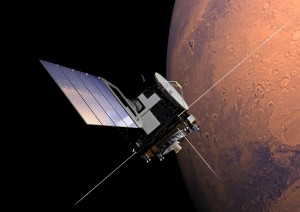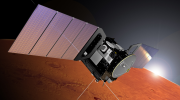If you read the web article last week announcing the planned support by Mars Express for NASA’s MSL landing on Mars (see ESA’s Mars Express supports dramatic landing on Mars), you may have come away with the impression that Mars Express will receive actual data transmitted by MSL during entry descent and landing.
As pointed out by Michael Khan, a mission analyst at ESOC, the way the article is worded is not actually wrong. However, anyone who doesn’t know the technical details might get the wrong impression.
“All that Mars Express will receive is the UHF [radio] carrier signal. From apparent changes in the received frequency, one can deduce at which speed relative to the MEX the landing craft is moving. Or — hopefully this will not be the case — if suddenly the signal stops, then we have an indication of when things went awry,” he points out.
“Mars Express can and does relay data for surface assets. But that is long after landing and requires MEX to pass very low over the landing site; not the situation we will have on Monday, 6 August.”
Michael added: “I guess you’ll be glad to see that at least one person reads the ESA web articles attentively!”
Thanks, Michael, for clarifying the signal-receipt situation for MEX next Monday – Ed.





Discussion: one comment
Hmm, “the way the article is worded” – as of right now – is clearly about MEX listening to a “flood of data” during MSL’s EDL and transmitting those later to Earth, just like the MRO will do. Also parallels are drawn to previous MEX support of the MER science data transmission, again leaving the impression that this is the plan now, while the words “carrier”, “Doppler” or other radio science terms do not appear at all. Thus as it is now the press release is anything but “not actually wrong” – but as it doesn’t contain any contact data (as each and every NASA press release does) one can’t even discuss these problems with its writer …